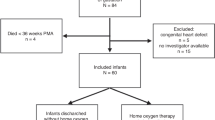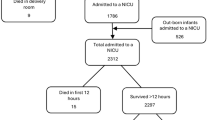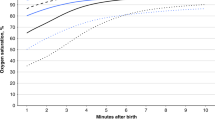Abstract
Objective
To determine associations of low superior vena cava (SVC) flow (≤55 ml/kg/min) and low right ventricular output (RVO) (≤150 ml/kg/min) in preterm infants.
Design/methods
An observational study in infants <30 weeks gestation randomized to receive immediate (<10 s) or delayed cord clamping (DCC) (≥60 s).
Results
The study enrolled 265 infants with a mean (SD) gestation 28 (2) weeks. Eighty-six (33%) infants had low SVC flow and 81 (31%) infants had low RVO. In multivariate analysis, low SVC flow was associated with gestation; low RVO was associated with DCC, gender and 5-minute Apgar; whereas mean RVO was negatively associated with both FiO2 and mean airway pressure (MAP) at 9 h and 24 h. Low SVC flow was associated with ductus arteriosus (DA) treatment. Infants with low RVO had higher mortality on univariate analysis, but this was not significant after adjusting for gestation.
Conclusions
SVC flow was associated with gestation, whilst RVO was associated with placental transfusion, gender, condition at birth, and early respiratory adaptation. Compared to infants with normal values, more infants with low SVC flow were treated for DA, but infants with low RVO had no significant difference in mortality or morbidity.
Similar content being viewed by others
Log in or create a free account to read this content
Gain free access to this article, as well as selected content from this journal and more on nature.com
or
Change history
15 April 2019
A correction to this paper has been published and can be accessed via a link at the top of the paper.
References
Saigal, S. & Doyle, L. W. An overview of mortality and sequelae of preterm birth from infancy to adulthood. Lancet 371, 261–269 (2008).
Hunt, R. W. et al. Low superior vena cava flow and neurodevelopment at 3 years in very preterm infants. J. Pediatr. 145, 588–592 (2004).
Osborn, D. A., Evans, N. & Kluckow, M. Hemodynamic and antecedent risk factors of early and late periventricular/intraventricular hemorrhage in premature infants. Pediatrics 112(1 Pt 1), 33–39 (2003).
Batton, B. et al. Blood pressure, anti-hypotensive therapy, and neurodevelopment in extremely preterm infants. J. Pediatr. 154, 351–357 (2009). 357e1.
Kluckow, M. & Evans, N. Low superior vena cava flow and intraventricular haemorrhage in preterm infants. Arch. Dis. Child. Fetal Neonatal Ed. 82, F188–F194 (2000).
Miletin, J. & Dempsey, E. M. Low superior vena cava flow on day 1 and adverse outcome in the very low birthweight infant. Arch. Dis. Child. Fetal Neonatal Ed. 93, F368–F371 (2008).
Evans, N. & Kluckow, M. Early determinants of right and left ventricular output in ventilated preterm infants. Arch. Dis. Child. Fetal Neonatal Ed. 74, F88–F94 (1996).
Glass, H. C. et al. Outcomes for extremely premature infants. Anesth. Analg. 120, 1337–1351 (2015).
Fanaroff, A. A., Hack, M. & Walsh, M. C. The NICHD neonatal research network: changes in practice and outcomes during the first 15 years. Semin. Perinatol. 27, 281–287 (2003).
Holberton, J. R. et al. The diagnostic value of a single measurement of superior vena cava flow in the first 24 h of life in very preterm infants. Eur. J. Pediatr. 171, 1489–1495 (2012).
Popat, H. et al. Effect of delayed cord clamping on systemic blood flow: a randomized controlled trial. J. Pediatr. 178, 81–86 (2016). e2.
Alverson, D. C. Neonatal cardiac output measurement using pulsed Doppler ultrasound. Clin. Perinatol. 12, 101–127 (1985).
Kluckow, M. & Evans, N. Superior vena cava flow in newborn infants: a novel marker of systemic blood flow. Arch. Dis. Child. Fetal Neonatal Ed. 82, F182–F187 (2000).
Popat, H. et al. Interobserver agreement and image quality of functional cardiac ultrasound measures used in a randomised trial of delayed cord clamping in preterm infants. Arch. Dis. Child. Fetal Neonatal Ed. 103, F257–F263 (2018).
Tarnow-Mordi, W. et al. Delayed versus immediate cord clamping in preterm infants. N. Engl. J. Med. 377, 2445–2455 (2017).
Osborn, D., Evans, N. & Kluckow, M. Randomized trial of dobutamine versus dopamine in preterm infants with low systemic blood flow. J. Pediatr. 140, 183–191 (2002).
Osborn, D. A., Evans, N. & Kluckow, M. Left ventricular contractility in extremely premature infants in the first day and response to inotropes. Pediatr. Res. 61, 335–340 (2007).
Osborn, D. A., Evans, N. & Kluckow, M. Effect of early targeted indomethacin on the ductus arteriosus and blood flow to the upper body and brain in the preterm infant. Arch. Dis. Child. Fetal Neonatal Ed. 88, F477–F482 (2003).
Miletin, J., Pichova, K. & Dempsey, E. M. Bedside detection of low systemic flow in the very low birth weight infant on day 1 of life. Eur. J. Pediatr. 168, 809–813 (2009).
Osborn, D. A. et al. Low superior vena cava flow and effect of inotropes on neurodevelopment to 3 years in preterm infants. Pediatrics 120, 372–380 (2007).
Cerbo, R. M. et al. Near-infrared spectroscopy monitoring, superior vena cava flow, and neurodevelopmental outcome at 2 years in a cohort of very low-birth-weight infants. Am. J. Perinatol. 33, 1093–1098 (2016).
Kluckow, M. & Evans, N. Low systemic blood flow and hyperkalemia in preterm infants. J. Pediatr. 139, 227–232 (2001).
Bates, S. et al. Superior vena cava flow and intraventricular haemorrhage in extremely preterm infants. J. Matern. Fetal Neonatal Med. 29, 1581–1587 (2016).
McGovern, M. & Miletin, J. A review of superior vena cava flow measurement in the neonate by functional echocardiography. Acta Paediatr. 106, 22–29 (2017).
Lakkundi, A., Wright, I. & de Waal, K. Transitional hemodynamics in preterm infants with a respiratory management strategy directed at avoidance of mechanical ventilation. Early Hum. Dev. 90, 409–412 (2014).
Popat, H. et al. Interobserver agreement and image quality of functional cardiac ultrasound measures used in a randomised trial of delayed cord clamping in preterm infants. Arch. Dis. Child. Fetal Neonatal Ed. 103, F257–F263 (2017).
Fogarty, M. et al. Delayed vs early umbilical cord clamping for preterm infants: a systematic review and meta-analysis. Am. J. Obstet. Gynecol. 218, 1–18 (2018).
Acknowledgements
We thank the parents and clinicians who gave their support to the conduct of the study, as well as Rebecca Brown for assistance with data management.
Funding
National Health and Medical Council project grant 571309
Author information
Authors and Affiliations
Contributions
H.P. participated in study design, patient recruitment, data analysis, data interpretation, and drafted the initial manuscript. K.P.R. participated in study design, data collection, and data analysis. A.K. participated in study design, data collection, and data analysis. L.S. supervised the project design and participated in data collection. N.E. participated in the design of the study and participated in patient recruitment and data acquisition. A.G. participated in the design of the study and participated in patient recruitment and data acquisition. M.K. participated in the design of the study and participated in patient recruitment and data acquisition. S.S. participated in patient recruitment and data acquisition. K.d.W. participated in the design of the study and participated in patient recruitment and data acquisition. W.T.-M. conceptualized and designed the study and participated in data analysis and interpretation. D.O. conceptualized and designed the study, participated in patient recruitment, data analysis and interpretation, and drafted the initial manuscript. All authors revised it critically for important intellectual content, approved the final manuscript as submitted, and agreed to be accountable for all aspects of the work.
Corresponding author
Ethics declarations
Competing interests
The authors declare no competing interests.
Additional information
Publisher’s note: Springer Nature remains neutral with regard to jurisdictional claims in published maps and institutional affiliations.
Rights and permissions
About this article
Cite this article
Popat, H., Robledo, K.P., Kirby, A. et al. Associations of measures of systemic blood flow used in a randomized trial of delayed cord clamping in preterm infants. Pediatr Res 86, 71–76 (2019). https://doi.org/10.1038/s41390-019-0348-1
Received:
Revised:
Accepted:
Published:
Issue date:
DOI: https://doi.org/10.1038/s41390-019-0348-1
This article is cited by
-
Intraventricular hemorrhage prediction in premature neonates in the era of hemodynamics monitoring: a prospective cohort study
European Journal of Pediatrics (2022)



